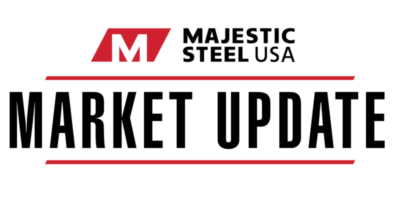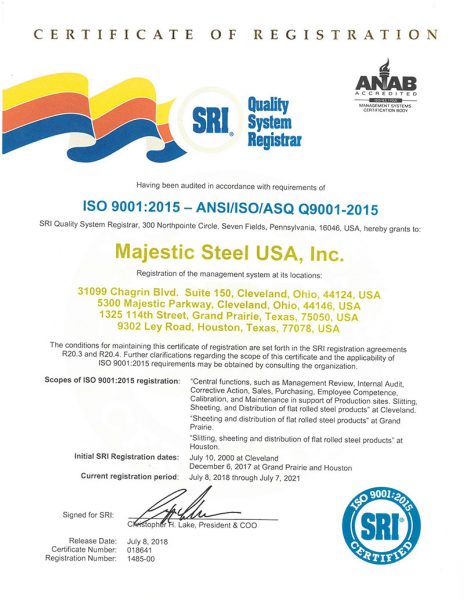Market Update | November 29, 2023
U.S. CONSUMER CONFIDENCE REBOUNDED IN NOVEMBER
After sliding in the previous three months, U.S. consumer confidence rebounded slightly in November. The Conference Board’s Consumer Confidence Index increased to 102.0, up from the downwardly revised 99.1 reading in October. The biggest issues that continue to weigh on consumers are inflation, geopolitical issues at home and abroad, and higher interest rates.
Input Costs
After climbing last week, zinc pricing held virtually flat this week on the back of slowing U.S. dollar (after the Fed hinted at an end to the rate increases).
- Zinc pricing held at $1.15/lb this week and has remained in a relatively tight range for the past month.
- The average over the past 30 days is $1.13/lb.
Iron ore pricing rebounded this week on the anticipation of a new round of stimulus announcements from China.
- Spot iron ore pricing came in at $135/mt, holding right around the YTD high.
Met coal pricing increased this week, climbing to $324/mt on increased buying interest from India coupled with steady Australian supply.
- This is up 4.5% from last week but is down 7.4% from this time last month.
Supply
U.S. raw steel production slipped again last week, dipping after a slight
increase previously.
- U.S. steelmakers produced 1.687 million tons at a 73.4% utilization rate.
- The current YTD utilization rate is at 75.6%, down 0.3% compared to the same time
last year.
Carbon steel imports continued to slide in October, sliding to a 10-month low.
- Carbon steel imports totaled 1.560 million tons, down 9.3% from September and down 11.5% from 1.761 million tons in October 2022.
- Carbon flat rolled imports declined as well, sliding 24.3% from September to
432,797 tons.- Flat rolled imports were down 14.3% on a year-over-year basis as well.
- Looking on a year-over-year basis, sharp drops in hot rolled and coated imports more than overcame the slight uptick in cold rolled imports.
- Hot rolled and coated imports declined 39.1% and 19.0%, respectively, while cold rolled imports increased by 2.7%.
- Year-to-date carbon flat rolled imports are now 26.2% below the rate from the same timeframe last year.
DEMAND
After seeing an increase in September, new home sales declined in October, now down for the second time in the last three months.
- October new home sales came in at a 679,000 unit rate, down 5.6% from September but were up 17.7% from the 577,000 unit rate in October 2022.
- This is the seventh consecutive month in which sales increased on a year-over-year basis.
- The inventory of unsold new homes at the end of October increased for the third consecutive month.
-
- New home inventory increased to 449,000 units, the highest level since last December.
- The current inventory, when combined with October’s sales pace, equates to 8.8 months of supply.
Despite the ongoing disruptions from the UAW strike, U.S. light vehicle production was only slightly impacted in October.
- US light vehicle production totaled 821,918 units, down 6.1% from September, and down 10.8% from 921,640 units in October 2022.
- Production has now declined, on a month-over-month basis, and has declined in four of the last five months.
- Production of light trucks saw the greater impact as production slipped 7.3% from September.
- Car production saw a slight decline, sliding 0.5% compared to the month prior.
- Despite the recent declines, year-to-date production is still up 7.0% compared to the same timeframe last year.
ECONOMIC
After sliding in the previous three months, U.S. consumer confidence rebounded slightly in November.
- The Conference Board’s Consumer Confidence Index increased to 102.0, up from the downwardly revised 99.1 reading in October.
- The Present Situation Index slipped slightly to 138.2 from 138.6 previously.
- The Expectations Index came in at 77.8, up from 72.7 in October.
- Despite the increase in the Expectations Index, the reading came in below 80 for the third consecutive month.
- Any reading below 80.0 historically signals a recession within the next year.
- The biggest issues that continue to weigh on consumers are inflation, geopolitical issues at home and abroad, and higher interest rates.
U.S. Gross Domestic Product continued to grow in Q3 as the second estimate showed annual grow of 5.2%.
- This is up from the initial estimate of 4.9% growth and final Q2 reading of
2.1% growth.- The update reflected upward revisions to nonresidential investment, and state and local government spending.
- These upward revisions were partly offset by downward revisions to consumer spending.
- Imports, which are a subtraction to GDP, declined.
- Compared to Q2, strong consumer spending, inventory investment, and exports helped overcome the slowing in nonresidential investment and increased imports.
This material, information and analyses (the “Content”) may include certain statements, estimates and projections prepared with respect to, among other things, historical data and anticipated performance. Content may reflect various assumptions by Majestic Steel USA, Inc. concerning anticipated results that are inherently subject to significant economic, competitive and other uncertainties and contingencies and have been included for illustrative purposes. Content is provided AS-IS.

